Casper David Friedrich
During our recent trip to Berlin, we got tickets to a special exhibit on the artist Casper David Friedrich, who was an important romantic painter in Germany. The exhibit was in the Altes Nationalgalerie on museum island in Berlin, which is a beautiful place simply to hang out. But our tickets were for 9 a.m., so our sightseeing had to wait.
Casper David Friedrich was born on September 5, 1774, and died on May 7, 1840. Although he is best known for his allegorical landscapes, you will not find the landscapes anywhere in nature. Friedrich used landscapes but changed them to create a mood, which often created an emotional connection with the viewer rather than a more literal interaction with the scene. This differentiated him from British and French Romanticists, who tended to emphasize more nostalgic or bucolic landscapes, and man's desire to conquer nature, respectively. The German approach depicts man's attempt to understand nature and, by extension, the divine.
The first paintings in the exhibit were two "pendent" paintings. The one of the left was The Monk on the Shore, and the one on the right was Monastery Cemetery in Snow.
 |
| The Monk on the Shore |
 |
| Monastery Cemetery in Snow |
The paintings really need to be seen in person. It is hard to see the various scales in one photo. In the Monastery Cemetery in Snow, the large scale of the trees and the monastery ruin both draw the eye upward from the small-scale monks walking into the ruin. An abbey ruin exists in Friedrich's home town in Greifswald, but Friedrich painted his ruin stretched upward, with the window in the apse much narrower than the window in the real ruin.
 |
| Eldena Abbey ruin in Greifswald |
You have get close to see the detail in the monks. And when you do, you see that the line of monks is led by a small group carrying a casket to a cross. And it is very easy to miss the date on the headstone on the right side of the painting. The year says 1812, the year Dresden (Friedrich's home at the time) was occupied by Napoleon's dreaded troops.
 |
| Detail of the monks |
 |
| Detail of tomb stones |
Now return to the left-hand painting. The Monk on the Shore is an empty expanse of sea and clouds, with a single monk, his back to us, viewing it as we do. Friedrich drew on his painting first with chalk or lead pencil, and this can be seen with an infrared reflectogram (also shown at the exhibit). An infrared reflectogram of The Monk on the Shore shows that Friedrich originally intended to have ships in the painting. But Friedrich painted over the ships, leaving the painting simple and empty with horizontal lines. And so the monk faces into the abyss.
 |
| Infrared reflectogram of Monk on the Sea |
This integration of spiritual significance with landscape painting made him a popular success.
Friedrich often put people in his painting. Sometimes it was a solitary
figure turned away from the viewer, towards and in communion with the
landscape. This kind of figure is known as "ruckenfigur," is another way
German Romanticism
differentiates itself from British and French Romanticism. In Woman at a
Window, the woman is looking out the window, presumably at ships. But
her view is different than our view, and we can only see the masts of
the ships.
| ||








